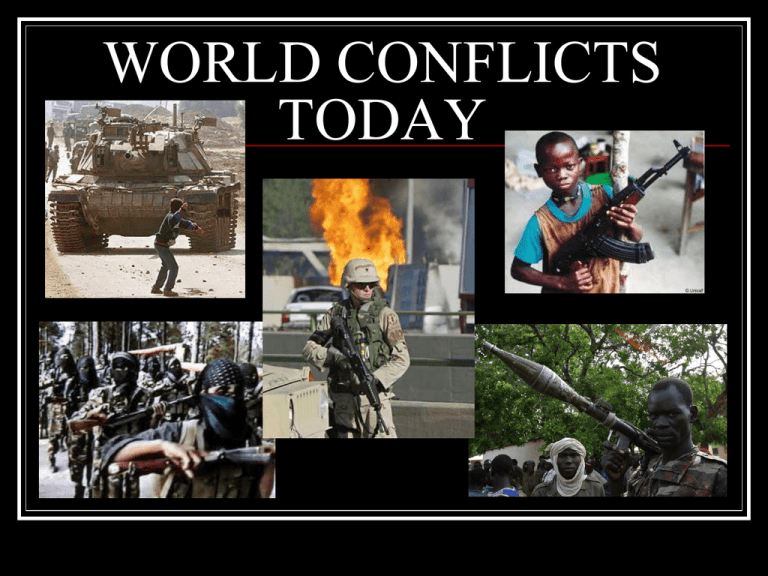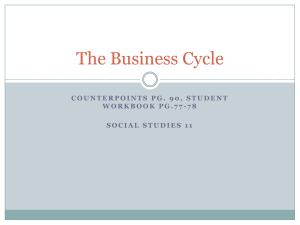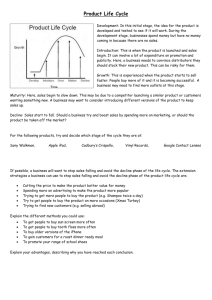world conflicts today
advertisement

WORLD CONFLICTS TODAY TOPICS DISCUSSED THE NATURE OF CONFLICTS TODAY ARMS SALES THE DECLINE OF THE UNITED STATES AND THE GLOBAL POWER SHIFT MILITARY INDUSTRIAL COMPLEX DISASTER CAPITALISM TERRORISM CONFLICTS IN THE 21ST CENTURY REGION NUMBER OF COUNTRIES IN REGION CONFLICTS (IN %) COUNTRIES WITH CONFICT (IN %) PERCENT OF WORLD CONFLICTS Africa Asia Europe Americas Middle East Totals 50 42 42 44 14 13 13 1 2 7 26 26 2 5 43 36 36 3 6 19 192 36 16 100 ANNUAL ARMS SHIPMENTS EXPORTERS OF ARMS BILLIONS /YEAR IMPORTERS OF ARMS BILLIONS /YEAR UNITED STATES $18 IRAQ & IRAN $6 RUSSIA $4.5 SAUDI ARABIA $3 FRANCE $4 INDIA $3 CUBA $2 VIETNAM $2 CHINA $2 ANGOLA $2 CZECHOSLOVAKIA $1 LIBYA $2 POLAND $1 EGYPT & SYRIA $2 GERMANY $1 AUSTRALIA &JAPAN $1 WORLD’S LARGEST DEFENSE BUDGETS Rank 1 Country United States a 2 China 3 Russia 4 a United Kingdom Spending ($ b.) World Share (%) % of GDP, 2011 711.0 41.0 4.7 143.0 8.2 2.0 71.9 4.1 3.9 62.7 3.6 2.6 5 France 62.5 3.6 2.3 6 Japan 59.3 3.4 1.0 7 Saudi Arabia 48.5 2.8 8.7 8 India 46.8 2.7 2.5 9 Germany 46.7 2.7 1.3 10 Brazil 35.4 2.0 1.5 World Total 1735 100 2.5 a b GLOBAL ARMS SALES Global sales of arms and military services by the 100 largest defense contractors increased in 2010 to $411.1 billion, according to the Stockholm International Peace Research Institute. The increase reflects a decade-long trend of growing military spending. Since 2002, total arms sales among the 100 largest arms manufacturers have increased 60 percent. What are some military costs? The most widely distributed weapon, the AK 47 costs about $30… or in Kenya about 5 cows. Keeping one American service member in Afghanistan costs between $850,000 and $1.4 million a year, depending on who you ask. But one matter is clear, that cost is going up. K2 Black Panther tank costs over 8.5 million The cost of F-18 is US $54.7 million TYPES OF CONFLICTS TODAY • • • • • • • • LOW INTENSITY LONG LASTING HIGH CIVILIAN DEATH TOLLS INTRA VS. INTER COUNTRY RELIGIOUS BASED CONFLICTS ETHNIC BASED CONFLICTS ASYMMETRIC IN NATURE INCREASINGLY RESOURCE BASED A GLOBAL SHIFT IN GEOPOLITICS 1. The fall of the Berlin Wall in 1989 (fall of Communism) and… 2. The subsequent victory of Capitalism as the main global economic ideology 3. The rise of Capitalism’s dominant manifestation in Globalization CONSEQUENCES The United States became the sole global super power. Capitalism and freeing of world markets lead to the rise of the multinational corporation and vastly increased global trade. The simultaneous acceptance of Capitalism as the preferred economic platform by China and India, and the out-sourcing of manufacturing and services by U.S. multinationals shifted the balance of trade in favour of Asia. …New Competition Emerges Growth rates of 9% in China fuelled huge economic reserves for military spending and the need to acquire huge energy resources. Vast new middle classes emerged in these countries and others with a ‘Western sized appetite’ for consumer products and energy use. GEOPOLITICAL SHIFT ….put in place a sequence of events that is changing the Balance of World Power. If the United States (champion of Capitalism and democracy) defeated the Soviet Union (Communism and totalitarianism), what lead to the decline? Shouldn’t the United States be better off? Decline of the United States Increase in U.S. debt…. Why? Funding wars and privatization of the military industrial complex without raising taxes or decreasing social programs ….and some enormous trade deficits with China and Canada. Decline of the United States 2. Political rifts in American two party system means nothing gets done politically. Partisanism (reluctant to acknowledge correctness on the part of their political opponents in almost any situation. and political polarization) Political Polarization Decline of the United States 3. Lack of spending on education and research and innovation within the United States has lead to a decline in competitive edge with emerging economies. 4. Lack of addressing of global climate change means a dependence on oil and the military spending to ensure supplies Lets take a look at only 1. Trade Deficit 2. The Privatization of the U.S. Military 3. The U.S. debt as reasons for the decline… TRADE DEFICIT President Regan (1980’s) lead the way to global trade and free markets as the Soviet Union was collapsing. President Bill Clinton (1990’s) furthered open trade by advocated China joining the World Trade Organization in the hopes of opening vast Chinese markets for U.S. products. IT BACKFIRED! In 2011 the deficit was $295 Billion USD Total U.S. debt is 15.6 Trillion USD $1 560 000 000 000 China trade rose from only $2 billion in 1979 to an estimated $459 billion in 2010. To put it in context: The United States and Canada conduct the world’s largest bilateral trade relationship, with total merchandise trade (exports and imports) exceeding $500 billion. PRIVATIZATION / CONTRACTORS The United States government has been paying billions of tax payer money to private corporations to do things that the U.S. government used to do. ie) health care, the military, pharmaceuticals communications, education, corrections, disaster relief, surveillance, policing, homeland security etc …. FOR A PROFIT All the companies that perform this work are known as contractors and perform the work for a profit with little or no oversight from the government… Profit taking, corruption, and conflict of interest between U.S. government officials and the companies they work for has lead to an erosion of democratic goals and the rise of corporate profits. It has meant what is now being termed a `hollow government``. In order to fulfill the tasks a government is entrusted to do for its citizens it must go to the corporate sector for the know how, and expertise. Many former government department jobs are now outsourced to the private sector





